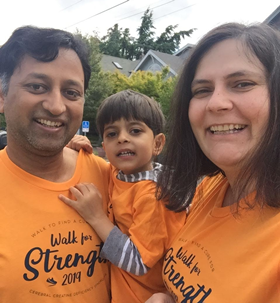 |
| Amar, Rohan, and Laura |
As a computer scientist, Laura Trutoiu knows that where there is a problem, there is a solution. That solution, or even just the path to a solution, may not be obvious at the start, but there is always a step to be taken. There is always an action that will move one closer to the light at the end of the tunnel. Forward momentum is the only option.
This worldview was critical when her son, Rohan, was diagnosed with a creatine deficiency at age 2. Laura and her husband Amar first noticed something might be wrong a year before when Rohan was small in size and not progressing as fast as expected. Their doctor was on top of it and sent them to a neurologist who insisted Rohan would grow out of it. That second opinion was reassuring, Laura said, but a little more than a year later, they knew there was something bigger at play. Exome testing confirmed the mystery symptoms were caused by an inherited disorder called creatine transporter deficiency (or CTD).
CTD is one of three disorders in a class called cerebral creatine deficiency syndromes (CCDS). Patients with CCDS have trouble creating or properly processing a compound called creatine due to genetic variations. Mostly known as a supplement in the world of weightlifting and competitive sports, creatine is essential to maintain the energy needed for development and deficiency in creatine can cause development delays, hyperactivity, seizures, and other symptoms, according to the National Organization for Rare Diseases.
“Our doctors were lovely people, but after the diagnosis they kept telling us that there was nothing we could do,” Laura said. “The scientist in me did not like that answer. There’s never nothing you can do.”
Quickly, Laura found the Association for Creatine Deficiencies (ACD) on Facebook. The group raises awareness for this class of disorder, advocates for early diagnoses, and backs research efforts. Within hours, she was on the phone with Heidi Wallis, the group’s vice president.
“We had so many questions: What do you do? Who are the doctors to see? How do you supplement?” Laura said. “Everything moved very fast after meeting Heidi.”
In the time since that conversation, Laura and her family got involved with the group and its mission. Laura is now ACD’s Director of Research and is focused on cultivating a collection of biological samples taken from CCDS patients to be offered to scientists interested in studying these disorders.
“We have a really good research community and we have people interested in conducting new research. We work with some scientists who are interested in samples to just try something new, but it can be challenging to get that access,” Laura said.
Laura turned to the National Institute for General Medical Science’s (NIGMS) Human Genetic Cell Repository for assistance. Housed and maintained here at the Coriell Institute for Medical Research, this NIGMS collection consists of a variety of different samples, including samples from patients with more than 1,000 rare, inheritable diseases. Started in 1972 as a collaboration between Coriell and the NIGMS, this collection and the samples in it have proven to be an invaluable resource for researchers around the world.
And for Laura, interested in growing a collection of samples, the repository offers her and her team a chance to avoid the huge cost of building their own collection from the ground up. The NIGMS repository is always adding to its collection of samples from patients with rare diseases and disorders, giving patients and advocates a chance to contribute to an established resource and ensure those precious materials will be available to as many qualified scientists as possible.
“Finding the Coriell Institute and the NIGMS repository has been huge for us. We don’t have the resources to do this on our own,” Laura said. “We have been very, very excited to have this opportunity. The more research we have, the greater chances of success we have. If that means making it more available, so be it.”
Outside of the biobank, ACD also works directly with the research community. The group offers seed research grants to interested scientists and held a meeting last year in Austin, Texas which brought families and scientists together. Laura said that event was a huge success and the group is organizing another to be held in Park City, Utah.
“We don’t discriminate on what kind of research we want. We want more. The diversity is important,” Laura said. “How do we feed these ideas to let them grow a little bit? All won’t blossom, but the more there are, the greater chance that one blooms.”
Now a couple of years after Rohan’s diagnosis, Laura said Rohan is still that sweet, happy kid, but their kitchen now resembles a bodybuilder’s closet, stacked with containers of various supplements to treat her son.
As for advice she’d offer parents who find themselves in the same place she was when Rohan was first diagnosed, she says walking together towards that solution is the only way to go.
“Find your tribe,” Laura said. “You’re a part of a community and we can all work together. We all realize that the chances are slim, but the chances are zero if we do nothing.”